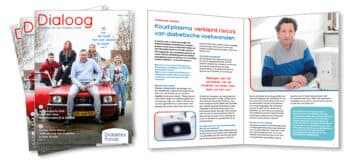Author: Diabetes Fonds, published in ‘Dialoog’, magazine 1 – 2021.
You bump your foot, a wound occurs. With diabetes this means double bad luck: wounds heal slower and bacteria have free rein. Moreover, a wound is often noticed late, due to reduced sensation in the feet. With the development of a medical cold plasma device, Koen Lim wants to reduce – and preferably heal – chronic wounds.
Who: Koen Lim is the medical director of Plasmacure, developer of PLASOMA cold plasma system
Goal: preventing complications such as infection and even amputation with a new treatment of diabetic foot ulcers
Why this mission?
“People underestimate the long-term consequences of a diabetic foot ulcer. A wound also has a major impact on a person’s daily life. Home carers come to visit your house for wound care, sometimes every day. Caregivers are needed, a walker. People are housebound and both the people with diabetes and their doctors are sometimes at their wits’ end, having trouble finding a solution. Our mission is to help improve the situation at an early stage.”
How does cold plasma work?
“Cold plasma is a special kind of gas. First of all, it kills bacteria (including antibiotic resistant ones), viruses and fungi. Secondly, it stimulates local blood perfusion and finally, it promotes the growth of skin cells. The technology behind the application of cold plasma to chronic wounds has been investigated further at the Eindhoven University of Technology. Our team brings it to the patient with PLASOMA, a medical device consisting of two components: a cold plasma pad and a cold plasma pulser. The pulser sends energy to the pad to create the cold plasma directly in the wound. The wound gets a boost and this has a favourable effect on wound healing.”
“Contributing to improving the quality of life, that’s what we do it for”
The first patients have been treated in studies. What are the results?
“In the first clinical study, we treated twenty people with diabetes with foot wounds that were on average three years old. After two weeks, two wounds had healed and in more than half, the wound area was found to have been reduced by more than fifty percent. And from the patients that are now being treated, we also hear, for example, that they regain sensation in their feet. We expect to improve the progress of the wound in at least half of the patients: to reduce the size of the wound and/or the number of bacteria so that the wound does not get bigger and no infection occurs.”
How does a treatment work?
“A specialised wound care nurse or other qualified healthcare professional performs the treatment. This only takes a short time, two minutes at a time. For good results, we expect around eight to twelve weeks of treatment to be needed, during which time you come to a wound care centre once or twice a week. But the device is easy to transport, so we hope that in time it will be possible to do it at home.”
The Diabetes Fonds is contributing to a clinical trial with PLASOMA. This is a follow-up to a previous Diabetes Fonds-funded study on foot wounds. In that study, researchers from Amsterdam UMC investigated whether it is safe to use the PLASOMA prototype with cold plasma to treat foot wounds in people with diabetes. Do you want to know more about the treatment with cold plasma? Go to diabetesfonds.nl/plasmacure (page is in Dutch)


